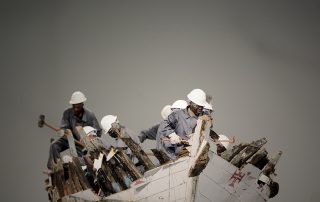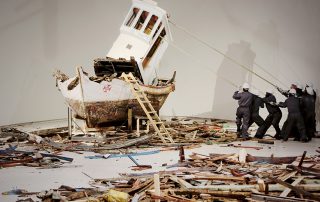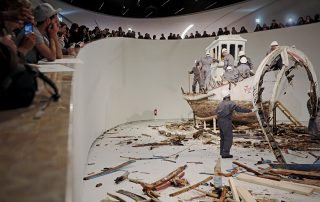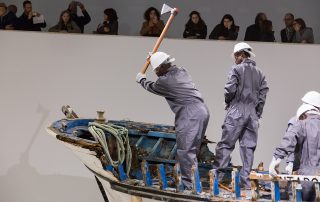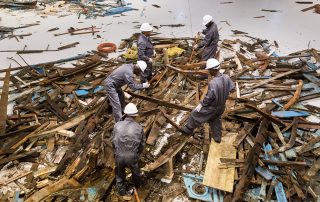ORDEM E PROGRESSO
MAAT – Museu de Arte, Arquitetura e Tecnologia22-03-2017 – 24-04-2017Upon entering the MAAT — Museum of Art, Architecture, and Technology, we come across the wreckage from several fishing boats scattered throughout the Oval Gallery. Are they the remnants of a vicious naval battle? Are they the result of an actual fight or are they the vestiges of some other action, deliberately left in this space?Ordem e Progresso is a new version of a performance-installation presented by Mexican artist Héctor Zamora (Mexico City, 1974) in 2012, in Paseo de los Héroes Navales, in Lima, and, in 2016, at the Palais de Tokyo, in Paris. Seven boats were selected for this new presentation, which was especially produced for the Oval Gallery. Of different kinds and with different features, the boats represent the traditional vessels of Portuguese fishing villages and cities, such as Sesimbra, Ericeira, Nazaré, Aveiro, and Figueira da Foz. The boats, autentic examples of Portuguese artisanal fishing, were selected because of their advanced state of degradation. They were all built between the late 1960s and the early 2000s. Some display national symbols that invoke the period of the Portuguese Discoveries; and others were baptized with names that refer to the traditions and mysticism of the fishing communities, or to the local culture and folklore.An evocation of the cultural and historical memory of the Portuguese maritime and fluvial heritage, Ordem e Progresso [Order and Progress] is also a reflection upon the environmental impact and socioeconomic consequences of the extinction of artisanal fishing and of its culture. The industrialization of the fishing sector had a strong impact on many Portuguese villages and cities. Following the guidelines of the European Union’s Common Fisheries Policy, the restructuring and re-dimensioning of the Portuguese fishing fleet meant the decommissioning of dozens of vessels, and the loss of some types of traditional ships. With its scathing and contemporary political message, Ordem e Progresso proposes a reflection upon the effects and consequences of progress, of globalization and of the market economy, raising a variety of political, economic, social, and cultural questions that include the current refugee crisis and the anti-immigration policies being enacted by certain world powers. The title of the piece is based on two maxims of positivist thought formulated by Auguste Comte (1798-1857), “love as a principle and order as the basis; progress as the goal,” and “progress is the development of order.” These maxims are also the inspiration for the motto we can read in the flag of Brazil (“Ordem e Progresso”), a country where the artist lived for several years. During an interview, Zamora has said that his goal with this piece was to “destroy the promises implied by the boats,” adding that, in the European context, “the boat has become a symbol of what is happening here [the migrant crisis]” and that “this is a critical moment, in which the world as a whole can question if this order and this progress have been positive at all.”1
In many cultures, the boat is a symbol of the voyage, of the transition between life and death. When we think about this, it is inevitable to reflect upon the growing number of refugees that die crossing the Mediterranean Sea, to consider the shocking images circulated by the media, showing overcrowded and precarious ships as they sink. The representation of the refugees by the media has been the subject of many debates and controversies. The more shocking and dramatic the image is, more intense (and effective) is the emotion it elicits. Images are now a game of deception: they are used to capture the public’s attention, to increase ratings, sales, and subscription numbers. The proliferation and multiplication of violent and disturbing images, many of which are devoid of informational value, inform us, above all, about the great fascination violence exerts over our species.
This brings us back to the idea that opens this text: the naval battle in the Oval Gallery. A space reminiscent of the architecture of the theatres of the classical period, elliptical spaces where the public was separated from the stage by an arena. These theatres were the stage of the famous (and bloody) naumachias—re-enactments of historical naval battles,2 usually in pools, lakes, or amphitheatres specially designed for them, surrounded by seating stands for the spectators. The microcosm of a heavily stratified, hierarchical society, the amphitheatre was the stage of a series of games and shows that used violence as a form of entertainment.
Zamora uses the configuration of the gallery to create a spatial boundary that separates the audience from the stage. The visitor is limited to the role of a passive spectator, watching as the fishing vessels are destroyed by a group of workers. Using manual tools such as mallets, hammers and axes, these actors/performers will turn these ships into pieces, as if they had been destroyed in a shipwreck or naval battle. Most of them immigrants themselves awaiting the opportunity of a job, the workers were hired through a Portuguese recruitment company. This particular detail is a pertinent and timely criticism of inequality in our contemporary world, of the inextricable relationship between the imperialist policies of the most powerful nations and the refugee crisis, but also of the way migration can be used as a tool and device for social transformation. In this perspective, there is a clear (and curious) parallel between these workers and the combatants in the original naumachias, who were mostly war prisoners, Christians, or slaves—the victims or Roman imperialism.
In Ordem e Progresso, body and action are politicized in an immersive performance, charged with theatricality and dramatism, and with a special focus on the poetics of the gesture. The presentation of this piece invites us to reflect upon the role of images, upon violence and upon the numbness of our contemporary society towards it. Much like in the games of the Roman world, this piece transforms the spectator into an abstract, passive, and contemplative subject, fascinated by the violent action of the destruction of the ships. Symbolically, the museum’s location by the Tagus is particularly significant, reverberating with the history of the Portuguese Discoveries and of the later consolidation of Lisbon as a port city and as a hub for maritime trade. Additionally, and looking at our present and recent past, this is also a place that was (and still is) witness to the relentless and voracious destruction of some of the symbols of our national identity, which were the victims of progress and modernity.
Ordem e Progresso presents u s w ith t he remnants of a battle a nd w ith t he body of another one, still in progress: the fight that tries to awaken us to a reflection upon the role of art in a time defined by the spectacularization and virtualization of life.Inês Grosso
1 Leticia Constant, “Artista destrói barcos em performance-protesto no Palais de Tokyo”, Radio France Internationale (May 6, 2016). [Accessed in Feb. 6, 2017]. [Available on the Internet: http://br.rfi.fr/cultura/20160506-artista-destroi-barcos-em-performance-protesto-no-palais-de-tokyo].
2 The date of the first naumachia (in Latin naumachia, from the Ancient Greek naumachía, literally “naval combat”) remains a controversial subject among historians. Nevertheless, the first known naumachia was offered by Julius Caesar to the people of Rome in 46 BC. For this purpose, Caesar ordered the construction of an artificial lake in Campus Martius. Several theories have sought to prove that the Colosseum was also used as the stage for these naval battles. In Portugal, small towns, such as Marialva, promoted naumachias in the artificial lakes that, via the aqueducts, supplied the public baths.
Ordem e Progresso é a nova versão de uma performance-instalação que o artista mexicano Héctor Zamora (Cidade do México, 1974) realizou em 2012 no Paseo de los Héroes Navales, em Lima, e em 2016 no Palais de Tokyo, em Paris. Para esta apresentação, pensada especificamente para a Galeria Oval, foram selecionados sete barcos de diferentes tipologias e características, de acordo com o tipo de atividade e conforme a tradição das cidades e vilas piscatórias portuguesas, como Sesimbra, Ericeira, Nazaré, Aveiro e Figueira da Foz. Verdadeiros exemplares da pesca artesanal portuguesa, construídos entre o final da década de 1960 e o início da de 2000, estas embarcações foram recolhidas tendo em conta o seu avançado estado de degradação. Algumas ostentam símbolos nacionais relacionados com o período dos Descobrimentos portugueses; outras foram batizadas com nomes que remetem para as tradições e o misticismo das comunidades piscatórias ou que estão vinculadas à cultura e ao folclore locais.
Além de evocar a memória histórica e cultural do património marítimo-fluvial português, Ordem e Progresso é também uma reflexão sobre o impacto ambiental e as consequências socioeconómicas resultantes da extinção da pesca artesanal tradicional e da cultura da pesca de subsistência. São muitas as cidades e vilas portuguesas afetadas pelo processo de industrialização do setor piscatório. Seguindo as medidas impostas pela Política Comum das Pescas da União Europeia, a reestruturação e o redimensionamento da frota portuguesa implicaram o abate de dezenas de embarcações, o que ditou o desaparecimento de alguns tipos de barcos tradicionais. Com uma mensagem política contundente e atual, Ordem e Progresso propõe uma reflexão sobre os efeitos e consequências do progresso, da globalização e da economia de mercado, e levanta uma diversidade de questões políticas, económicas, sociais e culturais, que se estendem à crise dos refugiados e às políticas anti-imigração decretadas por certas potências mundiais. O título da obra parte de duas máximas do pensamento positivista de Auguste Comte (1798-1857), «o Amor por princípio e a Ordem por base; o Progresso por objetivo» e «o progresso é o desenvolvimento da ordem», que deram também o mote à divisa («Ordem e Progresso») que se pode ler na bandeira do Brasil, país onde o artista viveu. Numa entrevista, Zamora referiu que, com esta obra, pretendia «destruir as promessas contidas nos barcos», acrescentando que, no contexto europeu, «o barco se tornou um símbolo do que está acontecendo aqui [a crise migratória]» e que «esse é um momento bastante crítico, em que o mundo todo pode se questionar se essa ordem e esse progresso nos levaram a algo positivo».1Em muitas culturas, o barco é um símbolo de viagem, da transição entre a vida e a morte. Quando pensamos nisto, é inevitável refletir acerca do número crescente de refugiados mortos ou desaparecidos durante a travessia do mar Mediterrâneo, e acerca das imagens chocantes que os media e as redes sociais fazem circular, mostrando naufrágios de embarcações precárias e sobrelotadas. A representação dos refugiados nos meios decomunicação social tem sido tema de vários debates e controvérsias. Quanto mais chocante e dramática a imagem, mais intensa (e eficaz) é a emoção que provoca. As imagens converteram-se em artifícios: são utilizadas para atrair a atenção do público e aumentar o número de leitores, vendas e subscrições. A crescente proliferação e multiplicação de imagens perturbadoras e violentas, muitas desprovidas de valor probatório e informativo, serve como indicador, acima de tudo, do grande fascínio que a violência exerce sobre a nossa espécie.Isto leva-nos de volta à ideia que abre o texto: a batalha naval que tomou conta da Galeria Oval. Um espaço que lembra a arquitetura teatral da Antiguidade clássica, por excelência de forma elíptica, com bancadas dispostas em redor de uma arena que separava a plateia do palco, onde aconteciam as famosas (e sangrentas) naumaquias – recriações de combates navais históricos,2 geralmente encenadas em lagos, tanques ou anfiteatros especialmente criados para o efeito e rodeados de arquibancadas para os espectadores. Microcosmo de uma sociedade fortemente hierarquizada e estratificada, o anfiteatro era o palco de uma série de jogos e espetáculos que recorriam à violência como forma de entretenimento.Zamora acentua e tira partido da configuração da Galeria Oval para criar uma separação espacial que divide palco e plateia. O artista coloca o público na posição de espectador passivo, assistindo à destruição performativa das embarcações por um grupo de trabalhadores. Utilizando unicamente ferramentas manuais, como marretas, martelos e machados, estes atores/performers irão destruir os barcos e deixar as suas carcaças em pedaços, como se tivessem sido destruídos num naufrágio ou numa batalha naval. Os operários foram contratados através de uma empresa portuguesa de recrutamento e são, na sua maioria, imigrantes à espera de uma oportunidade de emprego. Este facto particular é uma crítica oportuna e bastante atual às desigualdades do mundo contemporâneo, à relação indissociável entre as políticas imperialistas das nações mais poderosas e a crise dos refugiados, mas também à forma como a migração atua enquanto instrumento e mecanismo de transformação social. Neste sentido, há um evidente (e curioso) paralelismo com os naumaquiários (combatentes nas naumaquias), que eram, na sua maioria, prisioneiros de guerra, cristãos e escravos e, portanto, vítimas do imperialismo romano.
Em Ordem e Progresso, corpo e ação são politizados numa performance imersiva, carregada de teatralidade e dramaticidade, com ênfase na poética do gesto. A apresentação desta obra no MAAT propõe uma reflexão sobre o papel das imagens, sobre a violência e sobre a dessensibilização da sociedade contemporânea. Tal como nos jogos do mundo romano, o espectador é aqui transformado num sujeito abstrato, passivo e contemplativo, absorto na ação violenta da destruição dos barcos. No domínio do simbólico, a localização do museu nesta margem do Tejo é particularmente pertinente, reverberando com a história da expansão portuguesa no mundo e posterior consolidação de Lisboa como cidade portuária e polo de comércio marítimo. Adicionalmente, e olhando para o presente e passado recentes, este é também um local que testemunhou (e testemunha) a destruição implacável e voraz de símbolos identitários nacionais, vítimas do progresso e da modernidade.
Ordem e Progresso mostra-nos os restos de uma batalha e o corpo de outra, ainda em curso: a batalha que procura despertar-nos para uma reflexão sobre o papel da arte numa época definida pela espetacularização e virtualização da vida.
Inês Grosso
1 Leticia Constant, «Artista destrói barcos em performance-protesto no Palais de Tokyo», Radio France Internationale (6 mai. 2016). [Consult. 5 fev. 2017]. [Disponível na Internet: http://br.rfi.fr/cultura/20160506-artistadestroi-barcos-em-performance-protesto-no-palais-de-tokyo].
2 A data da primeira naumaquia (do grego naumakhía, «combate naval», pelo latim naumachĭa-, «idem») permanece um tema controverso entre os historiadores. No entanto, a primeira naumaquia conhecida foi oferecida por Júlio César ao povo de Roma em 46 a.C., tendo ordenado, para o efeito, a construção de um lago artificial no Campo de Marte. Diversas teorias têm procurado comprovar que o Coliseu também foi utilizado como palco para estas batalhas navais. Em Portugal, pequenas cidades como, por exemplo, Marialva realizaram naumaquias nos lagos artificiais que, através de aquedutos, abasteciam os banhos públicos.
